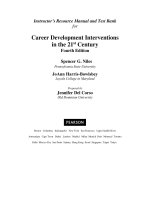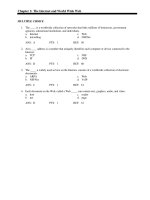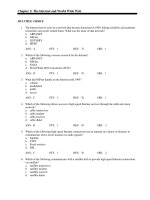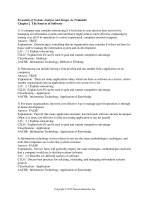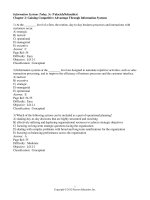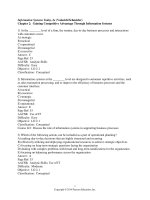Information systems today managing in the digital world 6th edition valacich test bank
Bạn đang xem bản rút gọn của tài liệu. Xem và tải ngay bản đầy đủ của tài liệu tại đây (339.54 KB, 35 trang )
Information Systems Today, 6e (Valacich/Schneider)
Chapter 2: Gaining Competitive Advantage Through Information Systems
1) At the ________ level of a firm, the routine, day-to-day business processes and interactions
with customers occur.
A) strategic
B) tactical
C) operational
D) managerial
E) executive
Answer: C
Page Ref: 53
AACSB: Analytic Skills
Difficulty: Easy
Objective: LO 2-1
Classification: Conceptual
2) Information systems at the ________ level are designed to automate repetitive activities, such
as sales transaction processing, and to improve the efficiency of business processes and the
customer interface.
A) tactical
B) executive
C) strategic
D) managerial
E) operational
Answer: E
Page Ref: 53
AACSB: Use of IT
Difficulty: Easy
Objective: LO 2-1
Classification: Conceptual
Course LO: Discuss the role of information systems in supporting business processes
3) Which of the following actions can be included as a part of operational planning?
A) making day-to-day decisions that are highly structured and recurring
B) effectively utilizing and deploying organizational resources to achieve strategic objectives
C) focusing on long-term strategic questions facing the organization
D) dealing with complex problems with broad and long-term ramifications for the organization
E) focusing on balancing performance across the organization
Answer: A
Page Ref: 53
AACSB: Analytic Skills; Use of IT
Difficulty: Moderate
Objective: LO 2-1
Classification: Conceptual
1
Copyright © 2014 Pearson Education, Inc.
4) At the ________ level of a firm, information systems are typically used to optimize processes
and to better understand the underlying causes of any performance problems.
A) tactical
B) executive
C) managerial
D) operational
E) strategic
Answer: D
Page Ref: 53
AACSB: Use of IT
Difficulty: Easy
Objective: LO 2-1
Classification: Conceptual
Course LO: Discuss the role of information systems in supporting business processes
5) With respect to decision making in organizations, ________ decisions are those in which the
procedures to follow for a given situation can be specified in advance.
A) comparitive
B) structured
C) unscrupulous
D) asymmetrical
E) disfigured
Answer: B
Page Ref: 53
AACSB: Use of IT
Difficulty: Easy
Objective: LO 2-1
Classification: Conceptual
6) Ben White is the manager of a retail store. His work typically includes the routine, day-to-day
interactions with customers and, once in a while, solving a customer's problem or dealing with a
dissatisfied customer. Additionally, he has to keep track of inventory and issue an order for
additional inventory with levels below a specified level. Ben is a(n) ________ level manager.
A) operational
B) tactical
C) strategic
D) managerial
E) executive
Answer: A
Page Ref: 53
AACSB: Analytic Skills; Use of IT
Difficulty: Moderate
Objective: LO 2-1
Classification: Application
Course LO: Discuss the role of information systems in supporting business processes
2
Copyright © 2014 Pearson Education, Inc.
7) With respect to organizational decision-making levels, ________ decisions can be
programmed directly into operational information systems so that they can be made with little or
no human intervention.
A) asymmetrical
B) semistructured
C) unstructured
D) comparitive
E) structured
Answer: E
Page Ref: 53
AACSB: Use of IT
Difficulty: Easy
Objective: LO 2-1
Classification: Conceptual
Course LO: Discuss the role of information systems in supporting business processes
8) Using information systems to optimize processes at the ________ level of an organization can
offer quick returns on the IS investment, as activities at this level are clearly delineated and well
focused.
A) executive
B) strategic
C) managerial
D) operational
E) tactical
Answer: D
Page Ref: 53
AACSB: Use of IT
Difficulty: Easy
Objective: LO 2-1
Classification: Conceptual
Course LO: Discuss the role of information systems in supporting business processes
9) At the ________ level of an organization, functional managers focus on monitoring and
controlling operational-level activities and providing information to higher levels of the
organization.
A) tactical
B) executive
C) strategic
D) superficial
E) illusive
Answer: A
Page Ref: 54
AACSB: Analytic Skills
Difficulty: Easy
Objective: LO 2-1
Classification: Conceptual
3
Copyright © 2014 Pearson Education, Inc.
10) The executive level of an organization is also known as the ________ level.
A) managerial
B) tactical
C) operational
D) strategic
E) illusory
Answer: D
Page Ref: 54
AACSB: Analytic Skills
Difficulty: Easy
Objective: LO 2-1
Classification: Conceptual
11) ________ decision making in an organization is referred to as semistructured decision
making because solutions and problems are not clear-cut and often require judgment and
expertise.
A) Illusive-level
B) Operational-level
C) Managerial-level
D) Executive-level
E) Strategic-level
Answer: C
Page Ref: 54
AACSB: Analytic Skills
Difficulty: Easy
Objective: LO 2-1
Classification: Conceptual
12) The managerial level of an organization is also known as the ________ level.
A) functional
B) tactical
C) executive
D) operational
E) strategic
Answer: B
Page Ref: 54
AACSB: Analytic Skills
Difficulty: Easy
Objective: LO 2-1
Classification: Conceptual
4
Copyright © 2014 Pearson Education, Inc.
13) Managers at the tactical level of an organization focus on ________.
A) deploying organizational resources to achieve the strategic objectives of the organization
B) routine, day-to-day business processes, and interactions with customers
C) long-term strategic questions facing the organization
D) complex problems with broad and long-term ramifications for the organization
E) the efficiency of business processes and the customer interface
Answer: A
Page Ref: 54
AACSB: Analytic Skills
Difficulty: Moderate
Objective: LO 2-1
Classification: Conceptual
14) Jane Estroisch works as a manager in a multidomestic firm. She focuses on the long-term
questions facing the organization such as which countries to compete in and what organizational
policies to follow. Jane is in the ________ level of the organization.
A) operational
B) tactical
C) executive
D) functional
E) managerial
Answer: C
Page Ref: 54
AACSB: Analytic Skills
Difficulty: Moderate
Objective: LO 2-1
Classification: Application
15) Managers in the ________ level of an organization are referred to as "executives."
A) operational
B) tactical
C) functional
D) strategic
E) managerial
Answer: D
Page Ref: 54
AACSB: Analytic Skills
Difficulty: Easy
Objective: LO 2-1
Classification: Conceptual
5
Copyright © 2014 Pearson Education, Inc.
16) ________ decisions deal with complex problems with broad and long-term ramifications for
an organization.
A) Executive-level
B) Functional-level
C) Tactical-level
D) Operational-level
E) Managerial-level
Answer: A
Page Ref: 54
AACSB: Analytic Skills
Difficulty: Easy
Objective: LO 2-1
Classification: Conceptual
17) With respect to organizational decision-making levels, for ________ decisions, some
procedures to
follow for a given situation can be specified in advance, but not to the extent where a specific
recommendation can be made.
A) unstructured
B) planned
C) semistructured
D) asymmetrical
E) structured
Answer: C
Page Ref: 54
AACSB: Analytic Skills
Difficulty: Easy
Objective: LO 2-1
Classification: Conceptual
18) At the ________ level of an organization, managers focus on long-term strategic questions
facing the organization, such as which products to produce, which countries to compete in, and
what organizational strategy to follow.
A) managerial
B) tactical
C) operational
D) executive
E) illusory
Answer: D
Page Ref: 54
AACSB: Analytic Skills
Difficulty: Easy
Objective: LO 2-1
Classification: Conceptual
6
Copyright © 2014 Pearson Education, Inc.
19) Managers at the ________ level include the president and chief executive officer, vice
presidents, and
possibly the board of directors.
A) functional
B) executive
C) tactical
D) operational
E) illusive
Answer: B
Page Ref: 54
AACSB: Analytic Skills
Difficulty: Easy
Objective: LO 2-1
Classification: Conceptual
20) ________ decisions are referred to as unstructured decisions because the problems are
relatively complex and non-routine.
A) Managerial-level
B) Tactical-level
C) Executive-level
D) Operational-level
E) Illusive-level
Answer: C
Page Ref: 54
AACSB: Analytic Skills
Difficulty: Easy
Objective: LO 2-1
Classification: Conceptual
21) To assist ________ decision making, information systems are used to obtain aggregate
summaries of trends and projections of the future.
A) managerial-level
B) functional-level
C) tactical-level
D) operational-level
E) executive-level
Answer: E
Page Ref: 54-55
AACSB: Use of IT
Difficulty: Easy
Objective: LO 2-1
Classification: Conceptual
Course LO: Discuss the role of information systems in supporting business processes
7
Copyright © 2014 Pearson Education, Inc.
22) At the ________ level of an organization, information systems provide KPIs that are focused
on balancing performance across the organization.
A) illusive
B) operational
C) tactical
D) managerial
E) executive
Answer: E
Page Ref: 55
AACSB: Analytic Skills
Difficulty: Easy
Objective: LO 2-1
Classification: Conceptual
Course LO: Discuss the role of information systems in supporting business processes
23) Information systems at the ________ level of an organization often help in automating
repetitive activities.
A) tactical
B) strategic
C) managerial
D) operational
E) executive
Answer: D
Page Ref: 56
AACSB: Use of IT
Difficulty: Easy
Objective: LO 2-1
Classification: Conceptual
Course LO: Discuss the role of information systems in supporting business processes
24) Which of the following actions would an organization take if it decides to pursue a best-cost
provider strategy?
A) offering the best prices in its industry on its goods and/or services
B) attempting to gain monopoly in the market by means of an unhealthy competition
C) offering products or services of reasonably good quality at competitive prices
D) providing high quality products at low prices in specific markets
E) offering low quality products at low prices with high quality after-sales services
Answer: C
Page Ref: 58
AACSB: Analytic Skills
Difficulty: Moderate
Objective: LO 2-1
Classification: Conceptual
8
Copyright © 2014 Pearson Education, Inc.
25) Which of the following is an example of a best-cost provider strategy?
A) Manufacturers like Ferrari, Aston Martin, and Lamborghini compete in the tiny super car
category with prices starting at $150,000 and running as high as $600,000.
B) Toyota's Lexus brand is considered a luxury car. Some of Lexus' models like the ES model,
however, are in the midrange of prices for cars.
C) Global furniture retailer Ikea provides customers with "affordable solutions for better living"
by offering home furnishings that combine good design, function, and quality with low prices.
D) Big Dog builds motorcycles that target only the very high end of the heavyweight market—
the high-end premium cruiser market—with names such as Pitbull, Wolf, Mastiff, and Bulldog.
E) Walmart's every day low prices (EDLP) strategy hinges upon Walmart's ability to obtain
consumer goods at the cheapest possible price and pass these savings on to consumers.
Answer: E
Page Ref: 58
AACSB: Analytic Skills
Difficulty: Difficult
Objective: LO 2-1
Classification: Application
26) Walmart pursues a ________ strategy, by which it offers the best prices in its industry on its
goods and/or services.
A) best-cost provider
B) decreased market share
C) low-cost leadership
D) broad differentiation
E) focused differentiation
Answer: A
Page Ref: 58
AACSB: Analytic Skills
Difficulty: Easy
Objective: LO 2-1
Classification: Conceptual
27) Which of the following is an implication for firms that have a threat of new entrants in their
market?
A) increased cost
B) reduced quality
C) increased demand for services
D) increased price
E) decreased market share
Answer: E
Page Ref: 62
AACSB: Analytic Skills
Difficulty: Moderate
Objective: LO 2-1
Classification: Conceptual
9
Copyright © 2014 Pearson Education, Inc.
28) Reduced prices, need for increased quality, and demand for more services from a firm would
result due to ________.
A) high threat of substitute products from other industries
B) high customers' bargaining power
C) high threat of new entrants into the market
D) traditional rivals within the industry
E) increased suppliers' bargaining power
Answer: B
Page Ref: 62
AACSB: Analytic Skills
Difficulty: Moderate
Objective: LO 2-1
Classification: Conceptual
29) ________ is the process of analyzing an organization's activities to determine where value is
added to products and/or services and what costs are incurred for doing so.
A) Value networking
B) Value chain analysis
C) Value migration
D) Value shop
E) Value grid trial
Answer: B
Page Ref: 63
AACSB: Analytic Skills
Difficulty: Easy
Objective: LO 2-1
Classification: Conceptual
30) With reference to assessing value for the IS infrastructure, architectural value is derived from
________.
A) the infrastructure's ability to enhance the profitability of the business
B) an investment's ability to extend the infrastructure's capabilities to meet business needs today
and in the future
C) an investment's impact on enabling the infrastructure to better meet business processing
requirements
D) assessing the extent to which an investment helps to meet requirements for control, security,
and integrity as required by a governing body or a key customer
E) the infrastructure's ability to improve product quality and customer satisfaction
Answer: B
Page Ref: 64
AACSB: Use of IT
Difficulty: Moderate
Objective: LO 2-1
Classification: Conceptual
Course LO: Discuss the key issues involved in managing the components of IT infrastructure
10
Copyright © 2014 Pearson Education, Inc.
31) While assessing value of the IS infrastructure, "before-and-after" assessments of
infrastructure characteristics such as interoperability, portability, scalability, recoverability, and
compatibility can be taken to measure ________ value.
A) economic
B) operational
C) regulatory
D) architectural
E) compliance
Answer: D
Page Ref: 64
AACSB: Use of IT
Difficulty: Easy
Objective: LO 2-1
Classification: Conceptual
Course LO: Discuss the key issues involved in managing the components of IT infrastructure
32) While assessing value of the IS infrastructure, ________ value is derived from assessing an
investment's impact on enabling the infrastructure to better meet business processing
requirements.
A) architectural
B) regulatory
C) operational
D) economic
E) compliance
Answer: C
Page Ref: 64
AACSB: Use of IT
Difficulty: Easy
Objective: LO 2-1
Classification: Conceptual
Course LO: Discuss the key issues involved in managing the components of IT infrastructure
33) While assessing value of the IS infrastructure, if we measure the impact of not investing in a
particular project, we are deriving the ________ value.
A) operational
B) economic
C) compliance
D) regulatory
E) architectural
Answer: A
Page Ref: 64
AACSB: Use of IT
Difficulty: Easy
Objective: LO 2-1
Classification: Conceptual
Course LO: Discuss the key issues involved in managing the components of IT infrastructure
11
Copyright © 2014 Pearson Education, Inc.
34) While assessing value of the IS infrastructure, ________ value is derived from assessing the
extent to which an investment helps to meet requirements for control, security, and integrity as
required by a governing body or a key customer.
A) architectural and tactical
B) tactical
C) operational
D) regulatory and compliance
E) economic
Answer: D
Page Ref: 64
AACSB: Use of IT
Difficulty: Easy
Objective: LO 2-1
Classification: Conceptual
Course LO: Discuss the key issues involved in managing the components of IT infrastructure
35) With respect to the components of a business model, a ________ is the utility that the
product/service has to offer to customers.
A) cost structure
B) value grid
C) value migration
D) value proposition
E) revenue stream
Answer: D
Page Ref: 65
AACSB: Analytic Skills
Difficulty: Easy
Objective: LO 2-1
Classification: Conceptual
36) With reference to assessing value for the IS infrastructure, ________ value is the
contribution an investment makes toward improving the infrastructure's ability to enhance the
profitability of the business.
A) architectural
B) operational
C) regulatory
D) compliance
E) economic
Answer: E
Page Ref: 66
AACSB: Use of IT
Difficulty: Easy
Objective: LO 2-1
Classification: Conceptual
Course LO: Discuss the key issues involved in managing the components of IT infrastructure
12
Copyright © 2014 Pearson Education, Inc.
37) Within the context of international business strategies, a global strategy is associated with
________.
A) low degree of global integration and high degree of local responsiveness
B) low degree of global integration and lack of local responsiveness
C) high degree of global integration and high degree of local responsiveness
D) low degree of global integration and low degree of local responsiveness
E) high degree of global integration and low degree of local responsiveness
Answer: E
Page Ref: 66
AACSB: Dynamics of the Global Economy
Difficulty: Easy
Objective: LO 2-2
Classification: Conceptual
38) Within the context of international business strategies, a firm that enjoys a high degree of
global integration and local responsiveness is pursuing a(n) ________ strategy.
A) transnational
B) global
C) international
D) multidomestic
E) home-replication
Answer: A
Page Ref: 66
AACSB: Dynamics of the Global Economy
Difficulty: Easy
Objective: LO 2-2
Classification: Conceptual
39) With respect to international business strategy, ________ is the corporate culture that has
evolved in the environment of the firm's home country.
A) value grid
B) transaction exposure
C) value proposition
D) free trade
E) administrative heritage
Answer: E
Page Ref: 66
AACSB: Analytic Skills
Difficulty: Easy
Objective: LO 2-2
Classification: Conceptual
13
Copyright © 2014 Pearson Education, Inc.
40) Home-replication strategy is also called the ________ strategy.
A) global
B) export
C) multidomestic
D) transnational
E) national
Answer: B
Page Ref: 66
AACSB: Dynamics of the Global Economy
Difficulty: Easy
Objective: LO 2-2
Classification: Conceptual
41) Which of the following international business strategies is the most basic form of going
global?
A) import strategy
B) global strategy
C) multidomestic strategy
D) home-replication strategy
E) transnational strategy
Answer: D
Page Ref: 66
AACSB: Dynamics of the Global Economy
Difficulty: Easy
Objective: LO 2-2
Classification: Conceptual
42) Which of the following statements is true about firms pursuing a home-replication strategy?
A) They attempt to achieve economies of scale by producing identical products in large
quantities for a variety of different markets.
B) They view their home operations as secondary to international operations thus providing a
minor role to information systems in facilitating this strategy.
C) They focus on their domestic customers' needs and wants and merely export their products to
generate additional sales.
D) They have a need to create integrated networks between the home office and the multiple
local subsidiaries.
E) They leverage the flexibility offered by a decentralized organization while at the same time
reaping economies of scale enjoyed by centralization.
Answer: C
Page Ref: 68
AACSB: Dynamics of the Global Economy
Difficulty: Moderate
Objective: LO 2-2
Classification: Conceptual
14
Copyright © 2014 Pearson Education, Inc.
43) Within the context of international business strategies, companies pursuing a(n) ________
strategy attempt to achieve economies of scale by producing identical products in large quantities
for a variety of different markets.
A) global
B) international
C) export
D) multidomestic
E) home-replication
Answer: A
Page Ref: 68
AACSB: Dynamics of the Global Economy
Difficulty: Easy
Objective: LO 2-2
Classification: Conceptual
44) Which of the following is a disadvantage of firms that pursue a global strategy?
A) lack of control over subsidiaries
B) limited knowledge transfer between individual subsidiaries
C) lack of interest in obtaining additional knowledge about foreign operations
D) inability to control decentralization
E) inability to react quickly to local challenges and opportunities
Answer: E
Page Ref: 68
AACSB: Dynamics of the Global Economy
Difficulty: Moderate
Objective: LO 2-2
Classification: Conceptual
45) Which of the following statements is true about firms pursuing a multidomestic business
strategy?
A) There is a huge amount of data and control information flow between the home and
subsidiary locations.
B) The knowledge transfer between subsidiaries is abundant.
C) They have standard offerings across markets and give preference to international business.
D) They are extremely flexible and responsive to the needs and demands of local markets.
E) They work in a centralized fashion and the home location exerts strong control on the
subsidiaries.
Answer: D
Page Ref: 69
AACSB: Dynamics of the Global Economy
Difficulty: Moderate
Objective: LO 2-2
Classification: Conceptual
15
Copyright © 2014 Pearson Education, Inc.
46) Which of the following is a disadvantage for firms pursuing a multidomestic business
strategy?
A) limited knowledge transfer between individual subsidiaries
B) exerting unnecessary control over subsidiaries
C) lack of interest in obtaining additional knowledge about foreign operations
D) inability to react quickly to local challenges and opportunities
E) restriction of decision-making ability of subsidiaries
Answer: A
Page Ref: 69
AACSB: Dynamics of the Global Economy
Difficulty: Moderate
Objective: LO 2-2
Classification: Conceptual
47) The ________ business strategy allows companies to leverage the flexibility offered by a
decentralized organization while at the same time reaping economies of scale enjoyed by
centralization.
A) international
B) global
C) multidomestic
D) transnational
E) home-replication
Answer: D
Page Ref: 70
AACSB: Dynamics of the Global Economy
Difficulty: Easy
Objective: LO 2-2
Classification: Conceptual
48) Which of the following actions distinguishes firms pursuing a transnational business strategy
from firms using business strategies?
A) responding to local challenges and opportunities quickly
B) exerting strong control over its subsidiaries
C) striking a balance between centralization and decentralization
D) responding to global challenges and opportunities quickly
E) standardizing product offerings to achieve economies of scale
Answer: C
Page Ref: 70
AACSB: Dynamics of the Global Economy
Difficulty: Moderate
Objective: LO 2-2
Classification: Conceptual
16
Copyright © 2014 Pearson Education, Inc.
49) Unilever, which decides when to centralize and when to decentralize depending on the
products and the local markets, is an example of a(n) ________ company.
A) transnational
B) home-replication
C) multidomestic
D) national
E) import
Answer: A
Page Ref: 70
AACSB: Dynamics of the Global Economy
Difficulty: Easy
Objective: LO 2-2
Classification: Conceptual
50) Mystic, a Texas-based fashion apparel company with subsidiaries in more than 25 countries
across the world, is one of the most recognized brands in the global and domestic markets. In a
recent interview with The New York Times, the CEO and the spearhead of Mystic Co. Burt
Swager said, "The secret of the company's success is its ability to strike the right balance
between centralization and decentralization." Mystic Co. is a firm that successfully pursues a(n)
________ business strategy.
A) global
B) transnational
C) home-replication
D) multidomestic
E) international
Answer: B
Page Ref: 70
AACSB: Analytic Skills; Dynamics of the Global Economy
Difficulty: Easy
Objective: LO 2-2
Classification: Application
51) According to ________, the number of transistors that could be squeezed onto a silicon chip
would double every 18 months.
A) Metcalfe's law
B) Megan's law
C) Murphy's law
D) Moore's law
E) Ashby's law
Answer: D
Page Ref: 74
AACSB: Use of IT
Difficulty: Easy
Objective: LO 2-3
Classification: Conceptual
17
Copyright © 2014 Pearson Education, Inc.
52) Within the context of organizational requirements for innovation, to deploy innovative
information systems well, people in the organization must be willing to do whatever they can to
bypass and eliminate internal bureaucracy, set aside political squabbles, and pull together for the
common good. These requirements can be categorized as ________ requirements.
A) process
B) customer
C) resource
D) quality
E) risk tolerance
Answer: A
Page Ref: 74
AACSB: Use of IT
Difficulty: Easy
Objective: LO 2-3
Classification: Conceptual
Course LO: Discuss the role of information systems in supporting business processes
53) Organizations deploying innovative information systems must have the human capital
necessary to deploy the new systems. These requirements can be categorized as ________
requirements.
A) resource
B) process
C) risk tolerance
D) customer
E) quality
Answer: A
Page Ref: 74
AACSB: Use of IT
Difficulty: Easy
Objective: LO 2-3
Classification: Conceptual
Course LO: Discuss the role of information systems in supporting business processes
54) ________ are new technologies, products, or services that eventually surpass the existing
dominant technology or product in a market.
A) Constructive innovations
B) Adaptive innovations
C) Disruptive innovations
D) Facultative innovations
E) Extensive innovations
Answer: C
Page Ref: 76
AACSB: Dynamics of the Global Economy
Difficulty: Easy
Objective: LO 2-3
Classification: Conceptual
Course LO: Discuss the role of information systems in supporting business processes
18
Copyright © 2014 Pearson Education, Inc.
55) According to the disruptive growth engine, executive leadership will allow a firm to
________.
A) effectively identify and evaluate potential disruptive innovations
B) gain credibility and to bridge sustaining and disruptive product development
C) gain the greatest disruptive opportunities
D) build a disruptive team of expert innovators
E) educate those closest to customers and competitors in order to identify opportunities
Answer: B
Page Ref: 78
AACSB: Dynamics of the Global Economy
Difficulty: Moderate
Objective: LO 2-3
Classification: Conceptual
56) Which of the following statements is true about the e-business innovation cycle?
A) The vertical dimension of the cycle shows the life expectancy of a particular information
technology, and the horizontal dimension shows time.
B) The vertical dimension of the cycle shows the extent to which an organization derives value
from a particular information technology, and the horizontal dimension shows time.
C) The vertical dimension of the cycle shows the expected investments required for a particular
information technology, and the horizontal dimension shows time.
D) The vertical dimension of the cycle shows the efficiency of a particular information
technology, and the horizontal dimension shows life expectancy of that information technology.
E) The vertical dimension of the cycle shows the user-friendliness of a particular technology, and
the horizontal dimension shows the amount of investment in that technology.
Answer: B
Page Ref: 81
AACSB: Use of IT
Difficulty: Moderate
Objective: LO 2-3
Classification: Conceptual
Course LO: Describe the effects of e-commerce on the modern business world
19
Copyright © 2014 Pearson Education, Inc.
57) In an e-business innovation cycle, after an organization scans the environment for new
emerging and enabling technologies, the next step is to ________.
A) create jobs, groups, and processes that are all devoted to scanning the environment
B) select the database and data storage advances
C) address the current opportunity to grab customers and market share
D) match the most promising new technologies with current economic opportunities
E) assess the value of the use of technology for customers and internal clients
Answer: D
Page Ref: 81
AACSB: Use of IT
Difficulty: Moderate
Objective: LO 2-3
Classification: Conceptual
Course LO: Describe the effects of e-commerce on the modern business world
58) Freeconomics is the leveraging of digital technologies to ________.
A) provide high quality products and services at low prices as a business strategy for gaining a
competitive advantage
B) allow free product information to customers as a business strategy for gaining a competitive
advantage
C) allow dissatisfied customers easy access to business premises and top management of the firm
D) match customer preferences with product features and increase the customer base
E) provide free goods and services to customers as a business strategy for gaining a competitive
advantage
Answer: E
Page Ref: 82
AACSB: Use of IT
Difficulty: Moderate
Objective: LO 2-4
Classification: Conceptual
Course LO: Discuss the role of information systems in supporting business processes
59) According to basic economics within a competitive marketplace, the price of a product is set
by its ________.
A) opportunity cost
B) sunk cost
C) marginal cost
D) transaction cost
E) fixed cost
Answer: C
Page Ref: 82
AACSB: Analytic Skills
Difficulty: Easy
Objective: LO 2-4
Classification: Conceptual
20
Copyright © 2014 Pearson Education, Inc.
60) Which of the following defines marginal cost?
A) It is the cost of an alternative that must be forgone in order to pursue a certain action.
B) It is the cost of producing an additional unit of output.
C) It is the cost that is independent on the level of goods or services produced by the business.
D) It is the cost that has already been incurred and cannot be recovered.
E) It is the cost incurred in making an economic exchange.
Answer: B
Page Ref: 82
AACSB: Analytic Skills
Difficulty: Moderate
Objective: LO 2-4
Classification: Conceptual
61) With respect to general approaches for applying freeconomics to various industries, sale
price of one item being reduced in order to sell something else of value is called ________
approach.
A) labor exchange
B) gift economy
C) freemium
D) zero marginal cost
E) cross subsidies
Answer: E
Page Ref: 85
AACSB: Analytic Skills
Difficulty: Easy
Objective: LO 2-4
Classification: Conceptual
62) With respect to general approaches for applying freeconomics to various industries, the
________ approach means creating an environment that allows people to participate and
collaborate to create something of value for everyone.
A) gift economy
B) freemium
C) cross subsidies
D) zero marginal cost
E) labor exchange
Answer: A
Page Ref: 85
AACSB: Analytic Skills
Difficulty: Easy
Objective: LO 2-4
Classification: Conceptual
21
Copyright © 2014 Pearson Education, Inc.
63) Which of the following actions of a firm suggests that it is using the freemium approach to
applying freeconomics?
A) providing free services to customers and getting paid for it by third parties
B) reducing the sale price of one item in order to sell something else of value
C) distributing products to customers without an appreciable cost to anyone
D) offering basic services for free, but charging a premium for special features
E) allowing people to participate and collaborate to create something of value
Answer: D
Page Ref: 85
AACSB: Analytic Skills
Difficulty: Moderate
Objective: LO 2-4
Classification: Conceptual
64) Musicmatch Jukebox is an all-in-one music management tool that was first marketed in
1999. Most users can use the Basic/Free version, but a $19.99 upgrade provides extra features
such as supertagging and faster ripping and burning. Which of the following explains this
approach to applying freeconomics?
A) labor exchange approach
B) freemium approach
C) zero marginal cost approach
D) cross subsidies approach
E) gift economy approach
Answer: B
Page Ref: 85
AACSB: Analytic Skills; Use of IT
Difficulty: Moderate
Objective: LO 2-4
Classification: Application
Course LO: Discuss the role of information systems in supporting business processes
22
Copyright © 2014 Pearson Education, Inc.
65) Wikipedia is a free, Web-based, collaborative, multilingual encyclopedia project supported
by the non-profit Wikimedia Foundation. Its 17 million articles have been written collaboratively
by volunteers around the world, and almost all of its articles can be edited by anyone with access
to the site. This allows people to participate and create something of value for everyone.
Wikipedia is pursuing a(n) ________ approach to applying freeconomics.
A) gift economy
B) zero marginal cost
C) labor exchange
D) cross subsidies
E) freemium
Answer: A
Page Ref: 85
AACSB: Analytic Skills; Use of IT
Difficulty: Moderate
Objective: LO 2-4
Classification: Application
Course LO: Discuss the role of information systems in supporting business processes
66) Tele'Wire, a mobile manufacturer, offers free connections to customers who buy its mobile
phones. This cost of connection is actually included in the price of the mobile phone. Tele'Wire
is pursuing a(n) ________ approach to applying freeconomics.
A) cross subsidies
B) gift economy
C) zero marginal cost
D) advertising
E) freemium
Answer: A
Page Ref: 85
AACSB: Analytic Skills
Difficulty: Moderate
Objective: LO 2-4
Classification: Application
23
Copyright © 2014 Pearson Education, Inc.
67) Web sites like ez-tracks and beemp3 pursue a(n) ________ approach to applying
freeconomics when they offer free music downloads for users because reproduction and
distribution of these products come at no cost.
A) gift economy
B) zero marginal cost
C) advertising
D) cross subsidies
E) freemium
Answer: B
Page Ref: 86
AACSB: Analytic Skills; Use of IT
Difficulty: Moderate
Objective: LO 2-4
Classification: Application
Course LO: Discuss the role of information systems in supporting business processes
68) Unstructured decisions can be programmed directly into operational information systems so
that they can be made with little or no human intervention.
Answer: FALSE
Page Ref: 53
AACSB: Analytic Skills
Difficulty: Easy
Objective: LO 2-1
Classification: Conceptual
Course LO: Discuss the role of information systems in supporting business processes
69) At the executive level, information systems are typically used to optimize processes and to
better understand the underlying causes of any performance problems.
Answer: FALSE
Page Ref: 53
AACSB: Use of IT
Difficulty: Easy
Objective: LO 2-1
Classification: Conceptual
Course LO: Discuss the role of information systems in supporting business processes
70) Tactical-level decision making is more structured and routine than operational-level decision
making.
Answer: FALSE
Page Ref: 54
AACSB: Analytic Skills
Difficulty: Easy
Objective: LO 2-1
Classification: Conceptual
24
Copyright © 2014 Pearson Education, Inc.
71) Managerial-level decision making is referred to as semistructured decision making.
Answer: TRUE
Page Ref: 54
AACSB: Analytic Skills
Difficulty: Easy
Objective: LO 2-1
Classification: Conceptual
72) Executive-level decisions are referred to as unstructured decisions.
Answer: TRUE
Page Ref: 54
AACSB: Analytic Skills
Difficulty: Easy
Objective: LO 2-1
Classification: Conceptual
73) With respect to the organizational decision making levels, top level managers typically focus
on problems
within a specific business function, such as marketing or finance.
Answer: FALSE
Page Ref: 54
AACSB: Analytic Skills
Difficulty: Easy
Objective: LO 2-1
Classification: Conceptual
74) For unstructured organizational decisions, few or no procedures to follow for a given
situation can be specified in advance.
Answer: TRUE
Page Ref: 54
AACSB: Analytic Skills
Difficulty: Easy
Objective: LO 2-1
Classification: Conceptual
75) Most organizations have three general decision-making levels: operational, managerial, and
executive.
Answer: TRUE
Page Ref: 55
AACSB: Analytic Skills
Difficulty: Easy
Objective: LO 2-1
Classification: Conceptual
25
Copyright © 2014 Pearson Education, Inc.

